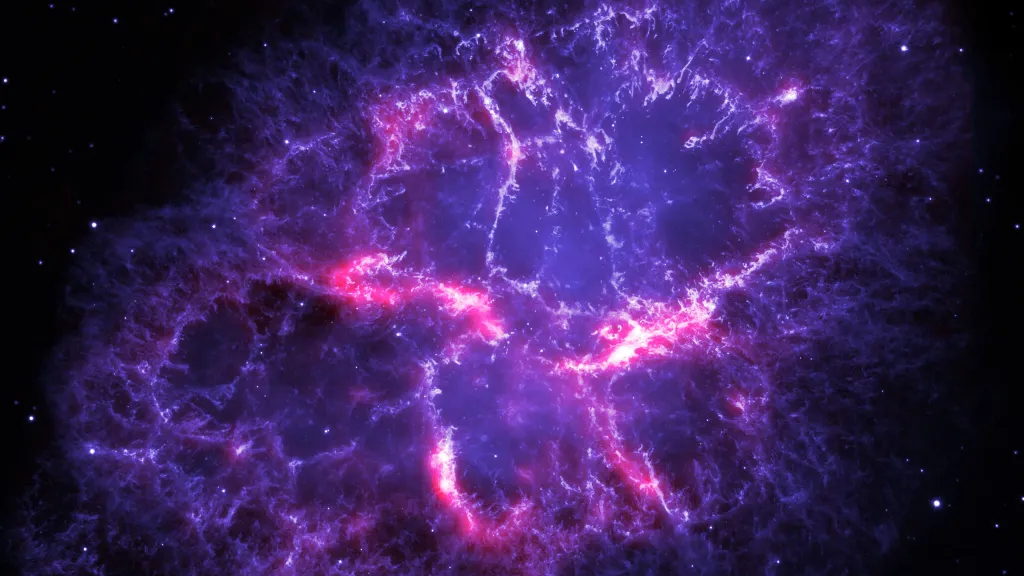Strange 'zebra' patterns are coming from the Crab Nebula — this physicist finally figured out why
A pulsar's radiation is getting refracted by plasma in the magnetosphere.

Historical records from around the world describe a bright star appearing in the sky in the year 1054. Today, astronomers are confident that what our ancestors were seeing was, in truth, a star that had gone supernova.
But this wasn't just any supernova. It was a supernova that would eventually lead to the formation of the Crab Nebula — a collage of interstellar gas and dust illuminated by the energy expelled during the death throes of a rapidly contracting nuclear furnace.The star in question would eventually become a pulsar — a rapidly rotating neutron star — sending pulses of electromagnetic radiation out into the ether. What's more, this particular pulsar seems to emit a "zebra"' pattern in the high-frequency band of the electromagnetic spectrum, which is unlike any other pulsar researchers have observed thus far.
And now, an astronomer from the University of Kansas thinks he has solved the riddle.
"The emission, which resembles a lighthouse beam, repeatedly sweeps past Earth as the star rotates," Mikhail Medvedev, lead author of the research, said in a statement. "We observe this as a pulsed emission, usually with one or two pulses per rotation. The specific pulsar I’m discussing is known as the Crab Pulsar, located in the center of the Crab Nebula 6,000 light-years away from us."
Strangely enough, Medvedev describes the Crab Pulsar as having a zebra pattern because its emissions exhibit an unusual band spacing in the electromagnetic spectrum proportional to band frequencies. "It's very bright, across practically all wave bands," Medvedev said.
"This is the only object we know of that produces the zebra pattern, and it only appears in a single emission component from the Crab Pulsar. The main pulse is a broadband pulse, typical of most pulsars, with other broadband components common to neutron stars," he added. "However, the high-frequency interpulse is unique, ranging between 5 and 30 gigahertz — frequencies similar to those in a microwave oven."
Breaking space news, the latest updates on rocket launches, skywatching events and more!
Astronomers first stumbled upon the pattern in 2007, but explanations have been scant.
Medvedev, though, was able to use a novel method for gauging the density of the pulsar's plasma — superheated charged particles that surround the dead star. He was then able to determine that the Crab Pulsar's plasma matter causes diffraction in the electromagnetic pulses responsible for the neutron star's singular zebra pattern.
"By analyzing the fringes, we can deduce the density and distribution of plasma in the magnetosphere. It's incredible because these observations allow us to convert fringe measurements into a density distribution of the plasma, essentially creating an image or performing tomography of the neutron star's magnetosphere," continued Medvedev.
"The Crab Pulsar is somewhat unique — it's relatively young by astronomical standards, only about a thousand years old, and highly energetic," he said. "But it’s not alone; we know of hundreds of pulsars, with over a dozen that are also young. Known binary pulsars, which were used to test Einstein's general relativity theory, can also be explored with the proposed method. This research can indeed broaden our understanding and observation techniques for pulsars, particularly young, energetic ones."
The study was published on Nov. 15 in the journal Physical Review Letters.

Conor Feehly is a New Zealand-based science writer. He has earned a master's in science communication from the University of Otago, Dunedin. His writing has appeared in Cosmos Magazine, Discover Magazine and ScienceAlert. His writing largely covers topics relating to neuroscience and psychology, although he also enjoys writing about a number of scientific subjects ranging from astrophysics to archaeology.
